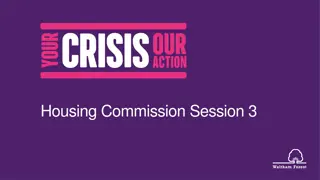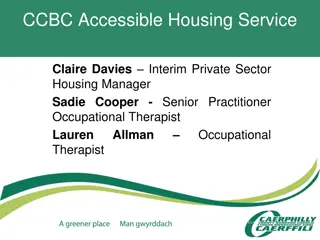Analyzing Housing Needs and Counting Skills for Housing Developers
Explore a math activity focused on understanding the number of homes needed versus the number available in a community. Students will observe housing types, estimate residents per home, and practice counting skills to determine housing shortages or surpluses. The task encourages critical thinking, problem-solving, and real-world application of mathematics.
Download Presentation

Please find below an Image/Link to download the presentation.
The content on the website is provided AS IS for your information and personal use only. It may not be sold, licensed, or shared on other websites without obtaining consent from the author. Download presentation by click this link. If you encounter any issues during the download, it is possible that the publisher has removed the file from their server.
E N D
Presentation Transcript
Whats the Problem? How many houses do we need? 3 ACT MATH TASK Kindergarten-2nd Except where otherwise noted, this work developed by Pacific Education Institute (PEI) for the Washington Office of Superintendent of Public Instruction, is available under a Creative Commons Attribution 4.0 License. All logos and trademarks are the property of their respective owners.
Learning Goals: Students will solve a range of complex well-posed problems in applied mathematics (SMP1). Students will solve a complex problem by making productive use of knowledge and problem-solving strategies (SMP2). Students will analyze complex, real-world scenarios (SMP4). Success Criteria: I can make sense of problems and persevere in solving them. (SMP1) I can explain what a value represents in my solution. (SMP2) I can use mathematics to solve and discuss real world problems. (SMP4)
What do you notice and wonder? When you walk around your community, observe the types of homes people live in. How many cars do you notice parked in front of the living spaces? Can you estimate how many adults live in the home? Image from Pixabay https://pixabay.com/illustrations/houses-clipart-road-trees-4918284/
What do you notice and wonder? Empty homes in the city: People who need homes in the city:
What do you notice and wonder? I noticed I am wondering
What kinds of math questions can we answer with this picture? Empty homes in the city: People who need homes in the city:
Housing developers need your counting skills! How many homes are available to live in? How many people need homes to live in? How many more people are there than homes?
What do you need to solve this problem? Relevant data Strategies for finding How many more? Strategies for comparing numbers Materials and supplies
Helpful Information and Tools Count out loud Line up and count 1, 2, 3, 4 1 2 3 4 Counting on 6, 7, 8, 9, 10 Touch and count 1 2 3 4 5 Recount!
Share your strategy Discussion sentence frames How many homes are there? I see _______ homes. How do you know? I see _______ homes in the (first, second, third, fourth) row. I can move the homes into groups of _______ and use skip counting. I can line up the homes and count each one.
Share your strategy Discussion sentence frames How many people are there? I see _______ people. How do you know? I can move the people into groups of _______ and use skip counting. I can line up the people and count each one.
Resolution How many more people are there than homes? 1 2 3 4 5 6 7 8 9 10 11 12 13 14 15 16 17
Self Reflection What did you learn today? Score yourself from 1-10 on each success criteria. A score of 10 means I know it so well, I could teach someone else. I can organize and represent data. I can count and compare numbers of objects.






























